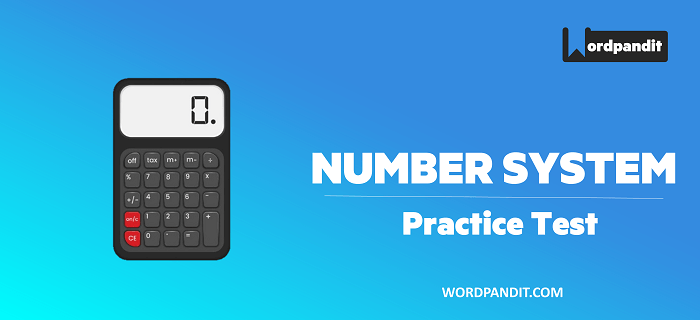- The test assesses your understanding of No. System.
- Questions belong to the very easy to easy difficulty range.
- Low scores point to a flaw in basic understanding of the concepts.
Number System Basics: Test 2
Congratulations - you have completed Number System Basics: Test 2.You scored %%SCORE%% out of %%TOTAL%%.You correct answer percentage: %%PERCENTAGE%% .Your performance has been rated as %%RATING%%
Your answers are highlighted below.
Question 1 |
Which of the following is a prime number?
171 | |
169 | |
237 | |
277 |
Question 1 Explanation:
171 = 57 x 3
169 = square of 13
237 = divisible by 3
277 is the last option and has to be the answer,
as it is not divisible by any number
169 = square of 13
237 = divisible by 3
277 is the last option and has to be the answer,
as it is not divisible by any number
Question 2 |
Which of the following cannot be a perfect square?
32761 | |
78530 | |
54289 | |
57121 |
Question 2 Explanation:
32761 = 181x181
78530 =2x5x7853
54289 =233x233
57121 =239x239
In these types of questions we find the range in which the number can lie.
For eg we know that 182= 324 so 1802=32400 and 1902=36100
now we know 32761 will lie between 180 and 190. Now check the last digit i.e 1
so it could be square of 181 or 189.
Now check both of them and reach to your answer.
Similarly do for every number.
78530 =2x5x7853
54289 =233x233
57121 =239x239
In these types of questions we find the range in which the number can lie.
For eg we know that 182= 324 so 1802=32400 and 1902=36100
now we know 32761 will lie between 180 and 190. Now check the last digit i.e 1
so it could be square of 181 or 189.
Now check both of them and reach to your answer.
Similarly do for every number.
Question 3 |
If p and q are two prime numbers then what can we said about pq?
it must be odd | |
it must be evenx | |
may be even | |
may be rational |
Question 3 Explanation:
Keep the following things in your mind:
In option A. 2 is a prime number, and all its powers will even.
In option B. All other prime numbers are odd, and will always have odd powers.
Hence, the given statement may be true, and option C is the correct answer.
In option A. 2 is a prime number, and all its powers will even.
In option B. All other prime numbers are odd, and will always have odd powers.
Hence, the given statement may be true, and option C is the correct answer.
Question 4 |
If N is a product of two prime numbers, P and Q, then what can we say about N?
N must be rational | |
N must be irrational | |
N must have 4 factors | |
Both a and c are correct |
Question 4 Explanation:
In this case, the factors of N are = 1, P, Q, N.
These are the only 4 factors for N, as it is given that P and Q are prime.
Also, P or Q can be 2, so that means it is not necessary that N will be odd.
This means both options A and C are correct. Hence, the correct answer is option D.
These are the only 4 factors for N, as it is given that P and Q are prime.
Also, P or Q can be 2, so that means it is not necessary that N will be odd.
This means both options A and C are correct. Hence, the correct answer is option D.
Question 5 |
Which of the following is the sum of two prime numbers?
81 | |
83 | |
89 | |
87 |
Question 5 Explanation:
Instead of finding two numbers, if we can apply the concept of addition of even and odd numbers,
then the problem is simplified.
Case 1: If one of the numbers is 2, then the sum will be odd (even+odd=odd).
Case 2: In case both the prime numbers are odd, then the sum should be even (odd+odd=even).
Now in this question, since the sum is odd,
we most definitely need 2 as one of the prime numbers.
Now simply carry out simple subtractions to identify the correct answer.
then the problem is simplified.
Case 1: If one of the numbers is 2, then the sum will be odd (even+odd=odd).
Case 2: In case both the prime numbers are odd, then the sum should be even (odd+odd=even).
Now in this question, since the sum is odd,
we most definitely need 2 as one of the prime numbers.
Now simply carry out simple subtractions to identify the correct answer.
Once you are finished, click the button below. Any items you have not completed will be marked incorrect.
There are 5 questions to complete.
List |












Could you please explain this solution?
For eg we know that 182= 324 so 1802=32400 and 1902=36100. How?
for 182=324,18^2=324
in the same way,1902=36100,19^2=361
Great perfect square practice.